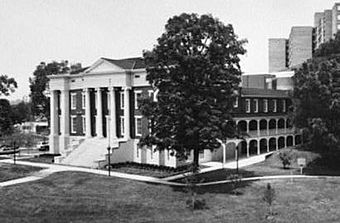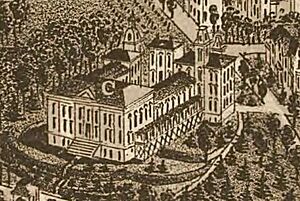Old City Hall (Knoxville) facts for kids
Quick facts for kids |
|
|
Old Knoxville City Hall
|
|

Old City Hall, from a 1983 HABS photograph
|
|
| Location | Summit Hill Drive Knoxville, Tennessee |
|---|---|
| Architectural style | Greek Revival |
| NRHP reference No. | 72001241 |
| Added to NRHP | May 31, 1972 |
The Old City Hall in Knoxville, Tennessee, is a group of old buildings with a lot of history! It's located at 601 West Summit Hill Drive. This place wasn't always a city hall. It started in 1848 as a school for deaf students, called the Tennessee School for the Deaf and Dumb. Later, from 1925 to 1980, it became where Knoxville's city government worked. Today, it's home to Lincoln Memorial University's Duncan School of Law. This historic complex is recognized on the National Register of Historic Places.
Contents
Building Design and Style
The Old City Hall complex is found at a busy intersection in Knoxville. This includes Summit Hill Drive, Western Avenue, Broadway, and Henley Street. The L&N Station is across the street. The complex has five buildings connected together. The main building was finished in 1848. Four more buildings were added behind it between 1874 and 1899. All these buildings sit on top of a small, tree-covered hill.
The main building has a front section that is three stories tall. It also has two wings at the back, making the building look like a "U" shape. The front of the building has a grand entrance with four tall Ionic columns. These columns hold up a large triangular section called a pediment. You can reach this entrance by walking up a marble staircase. Some of the newer parts of the building have different styles. One part looks like Italian Renaissance design. Another part has features from the Neoclassical style. The inside of the buildings has been changed many times. This happened as the buildings were used for different things over the years.
A Look Back in Time
The Old City Hall buildings have a long and interesting past. They have served different important roles in Knoxville's history.
School for the Deaf
The Tennessee School for the Deaf was first called the Tennessee School for the Deaf and Dumb. It was approved by the state in 1844. A man named John Cocke, a state senator, helped make this happen. A Knoxville merchant named Calvin Morgan gave the land for the school. Construction started in 1846. Jacob Newman was in charge of building it and was likely the architect. The school officially opened in 1848.
More and more students joined the school in the 1850s. But it had to close when the Civil War began. Confederate soldiers used the school as a hospital. Later, Union soldiers captured Knoxville and also used the school as a hospital. The school finally reopened in December 1866.
In 1873, the state gave the school money to grow. A new classroom building was finished in 1874. A chapel and auditorium building was added in 1879. Another classroom building was built in 1891. A hospital building was constructed in 1899. The school stayed at this location until 1924. Then, it moved to a new campus in South Knoxville.
Becoming City Hall
Knoxville's first city hall was a small building built in 1868. It was located on Market Square. Before that, the city government met at the Knox County Courthouse. The first city hall building was replaced by a bigger one in 1888. This second building was part of a new market house built in 1897. The city government still met on its second floor.
In 1923, Knoxville bought the Tennessee School for the Deaf complex. They wanted to use it as the new city hall. The city council held its first meeting there in February 1925. For many years, important decisions about Knoxville were made in this building. Local historian Jack Neely said that many big choices were made here. These included things like ending segregation and planning for the World’s Fair. Many city leaders worked here, discussing important topics for the city.
In the early 1930s, there were plans to move a school into the City Hall complex. However, the city offices needed more and more space. So, these plans never happened.
Recent Times
Over the years, the land around Old City Hall got smaller. Some parts were used for new buildings and roads. In the 1950s, some buildings were torn down for a new parking lot. In 1975, a small house was removed. Three years later, the Summit Hill Towers were built nearby.
In 1980, the City of Knoxville moved its main offices. They moved to the new City-County Building on Main Street. After that, different groups used Old City Hall. In 2008, Lincoln Memorial University started leasing the building. They opened their new law school there, called the Duncan School of Law.
See also
- List of mayors of Knoxville, Tennessee
- Customs House, Knoxville
- History of Knoxville, Tennessee
- Knox County Courthouse (Tennessee)
- United States Post Office and Courthouse (Knoxville, Tennessee)
Images for kids




